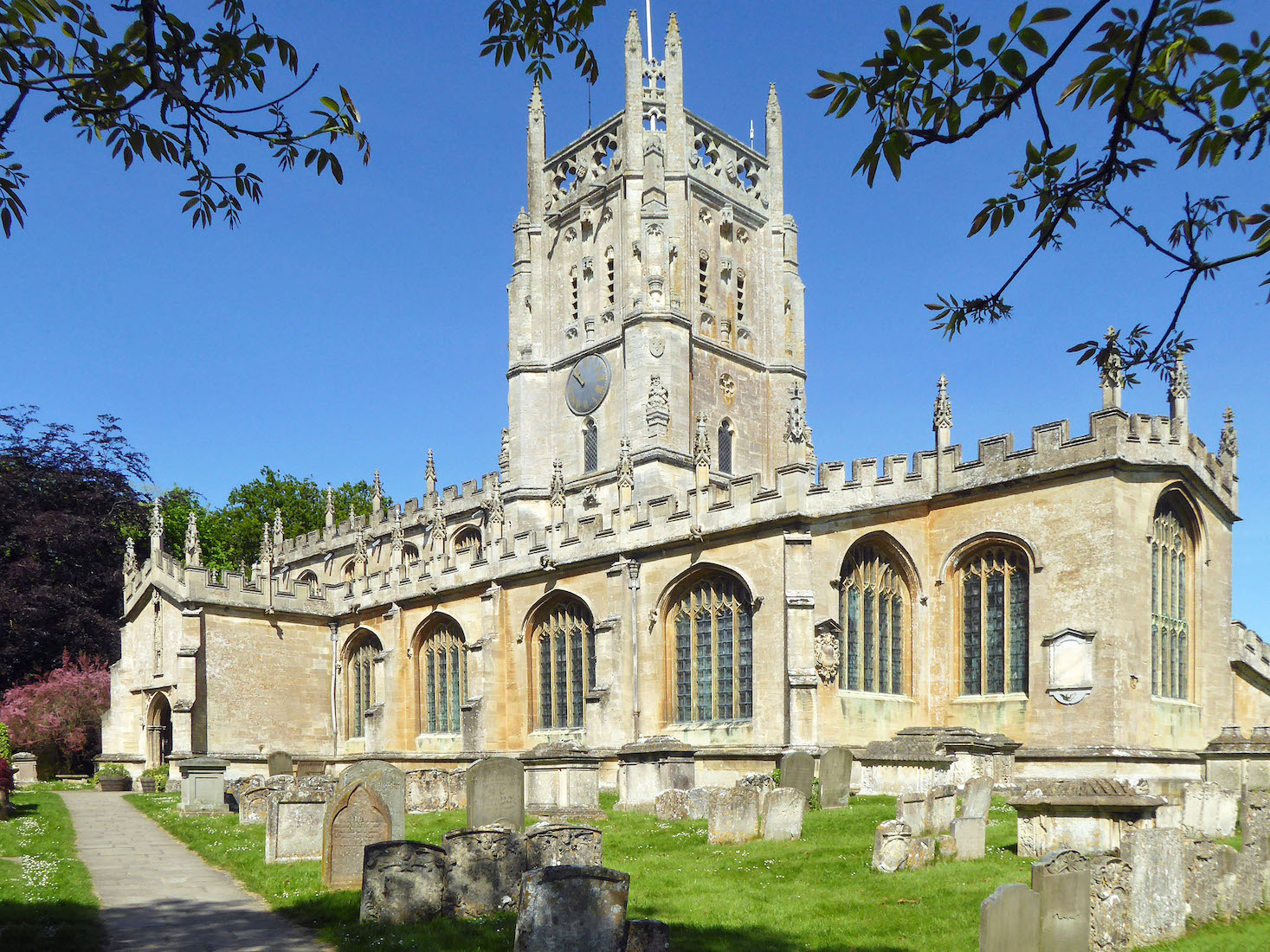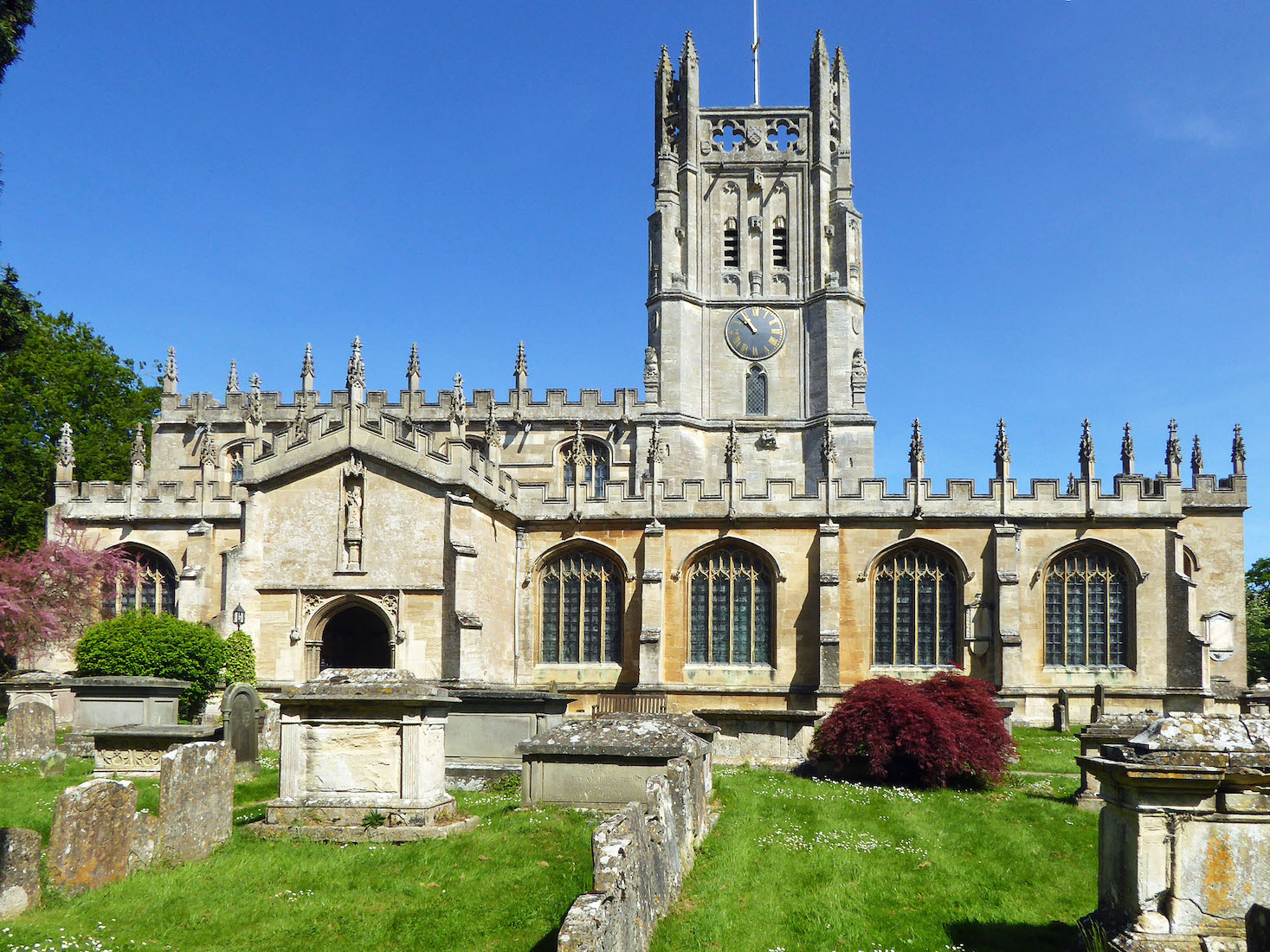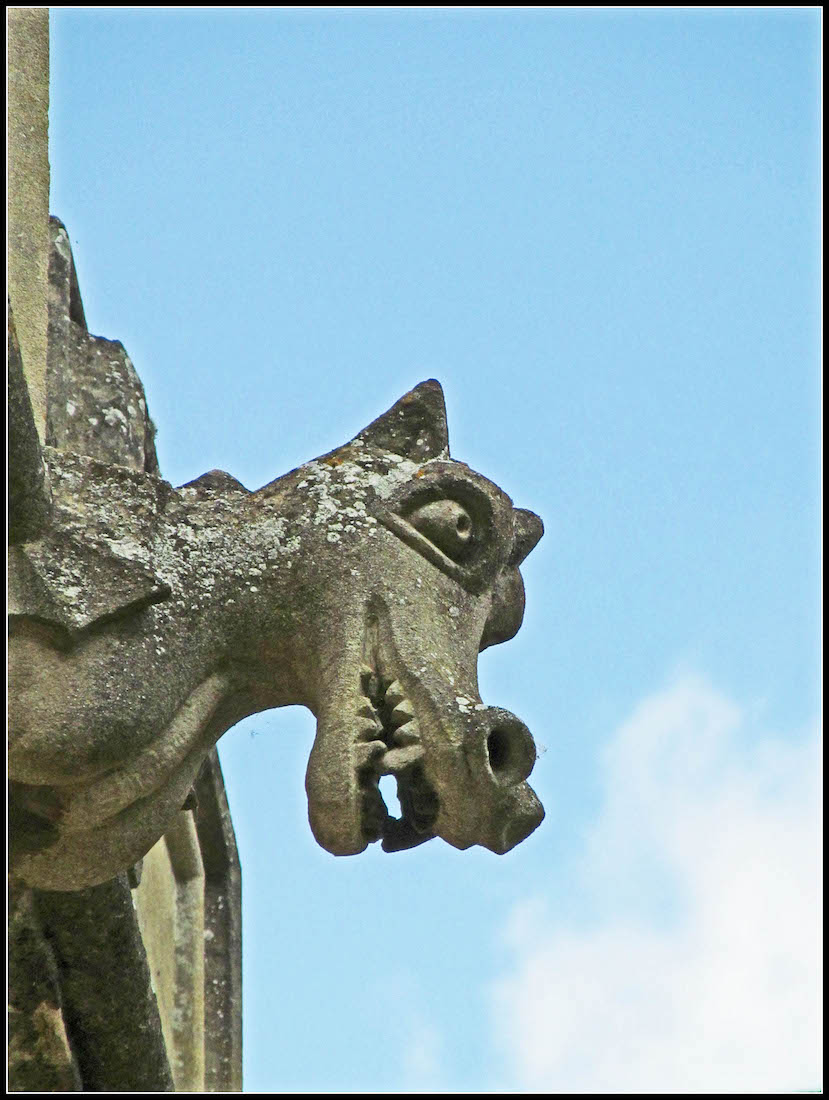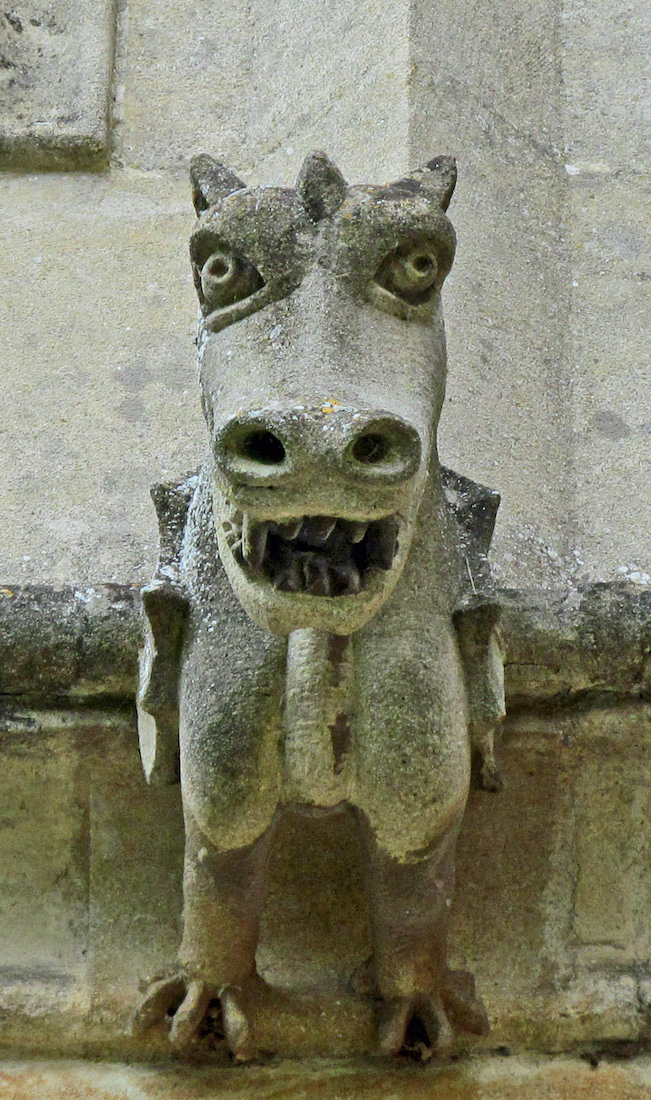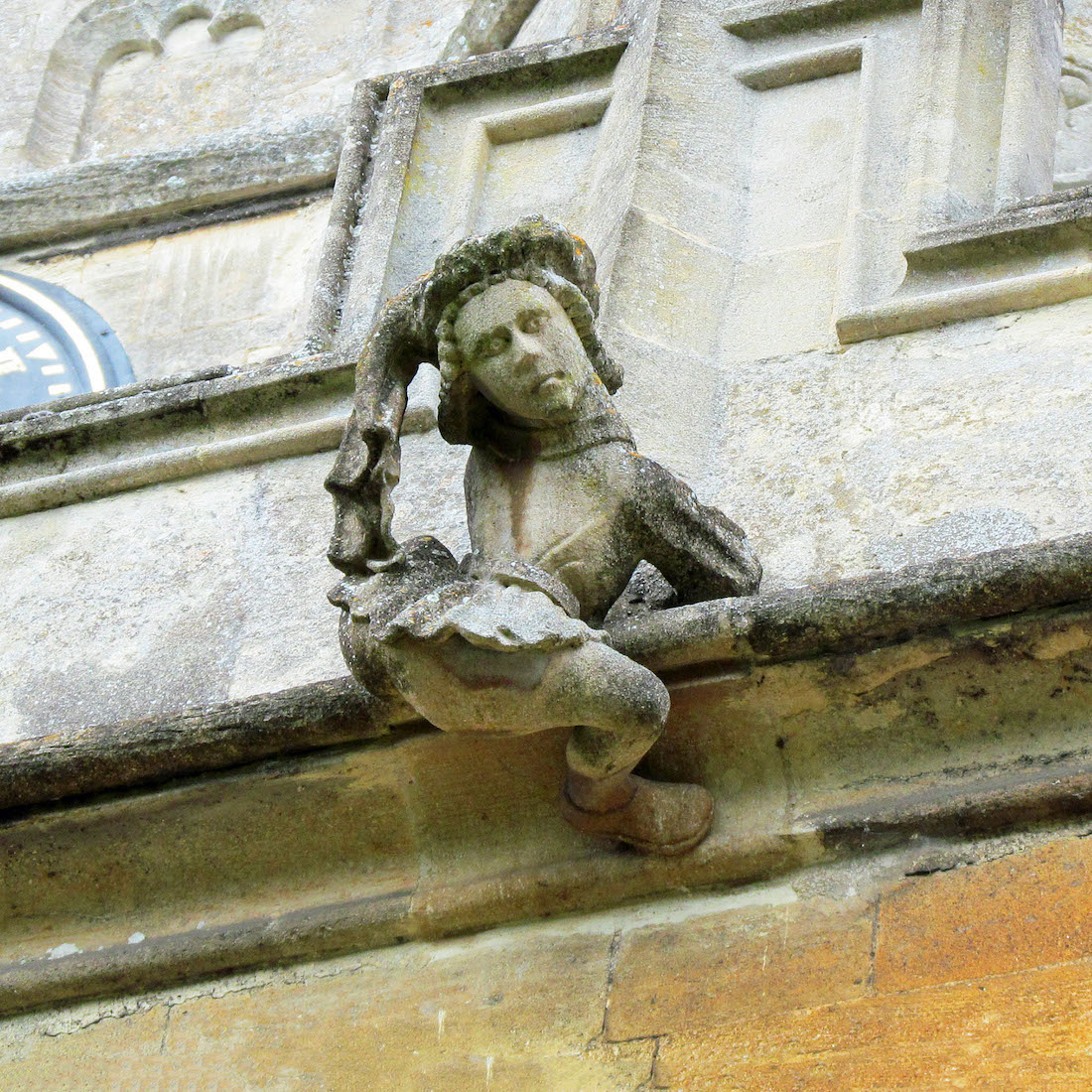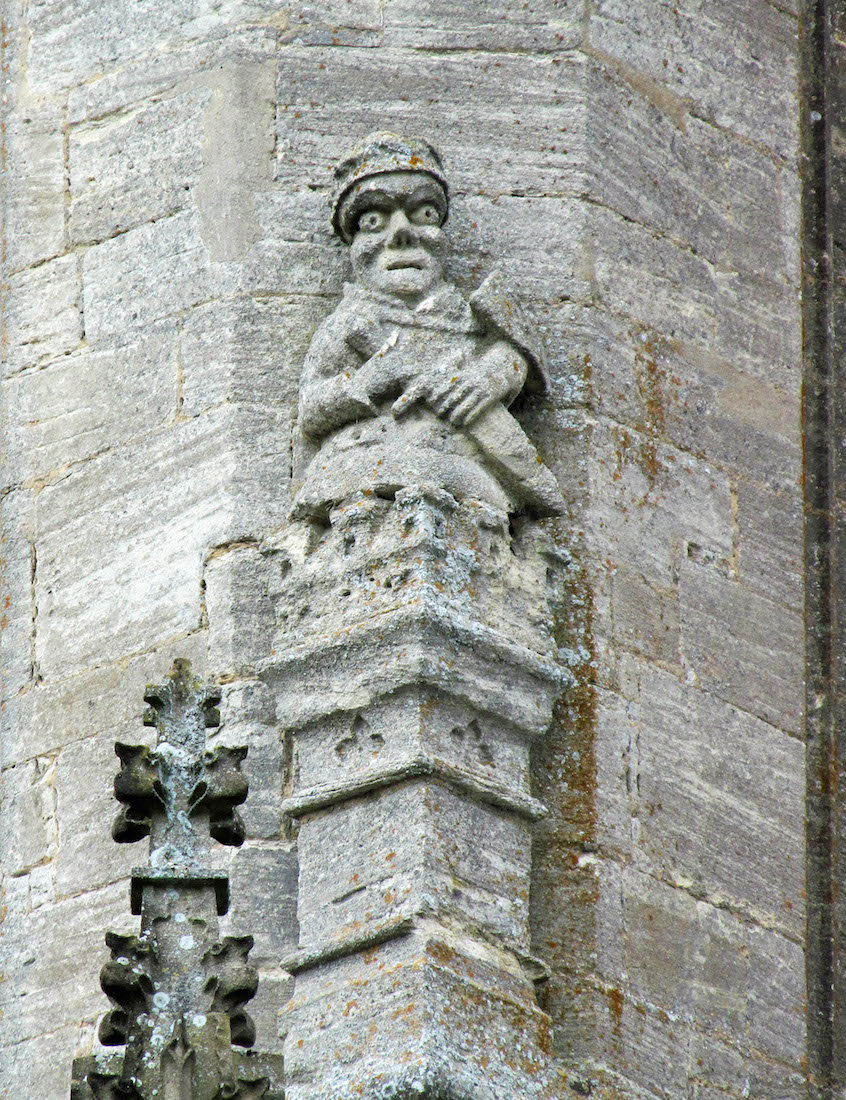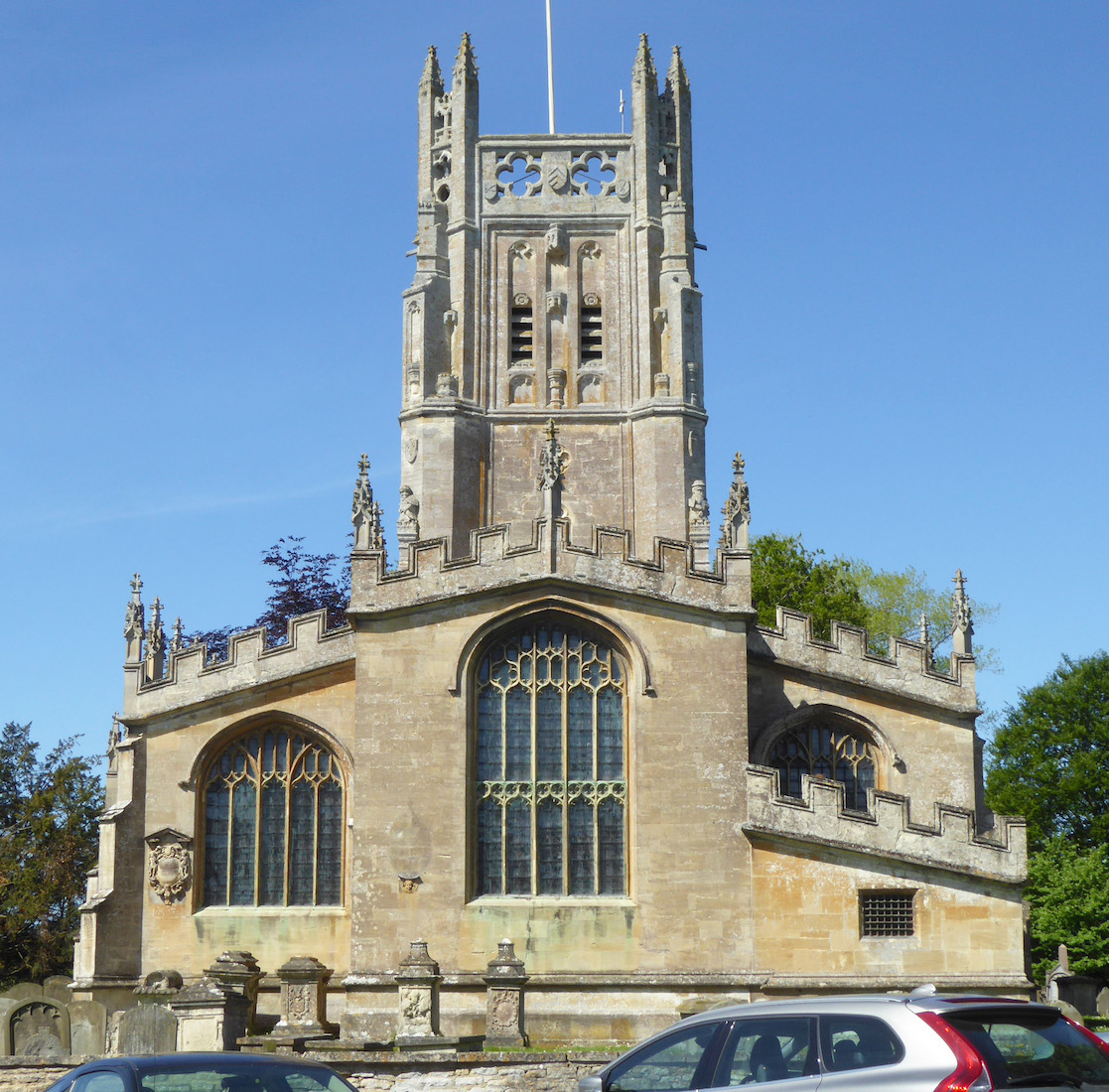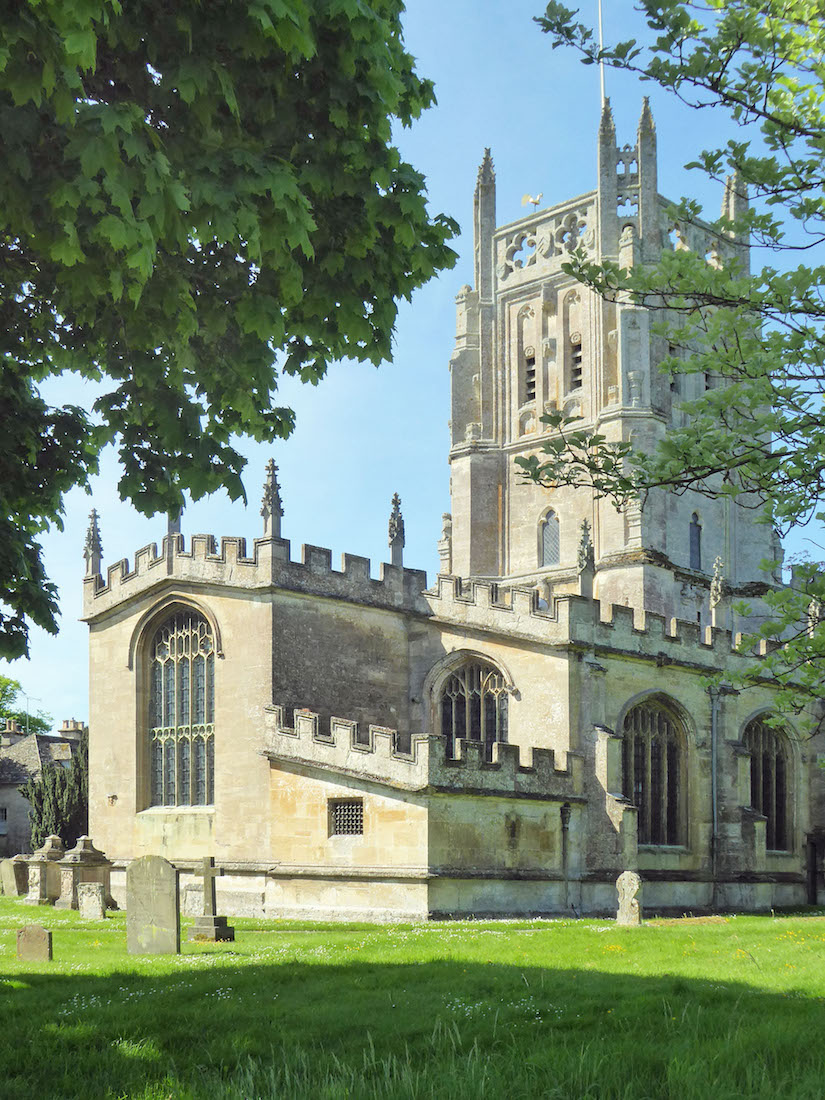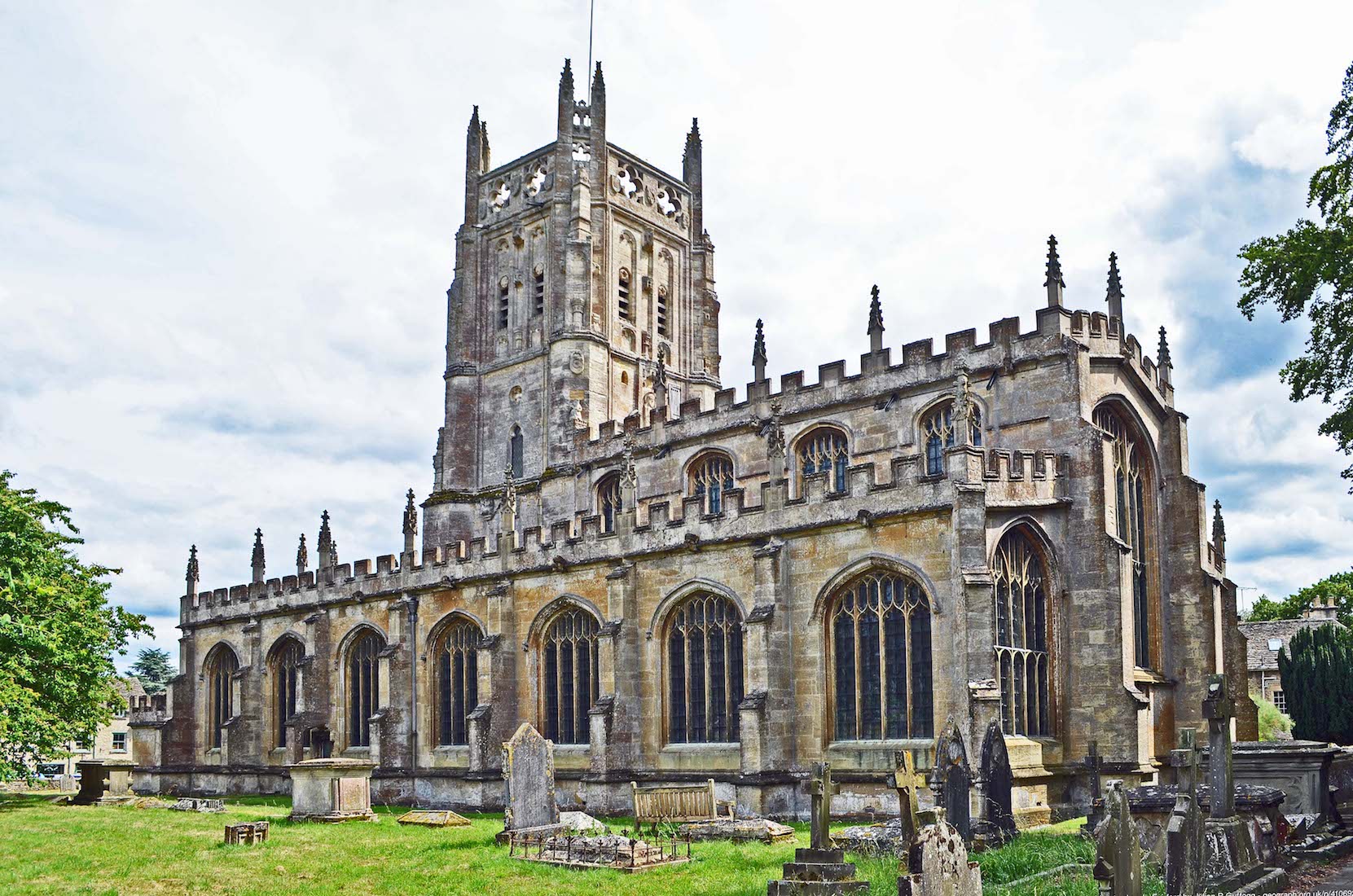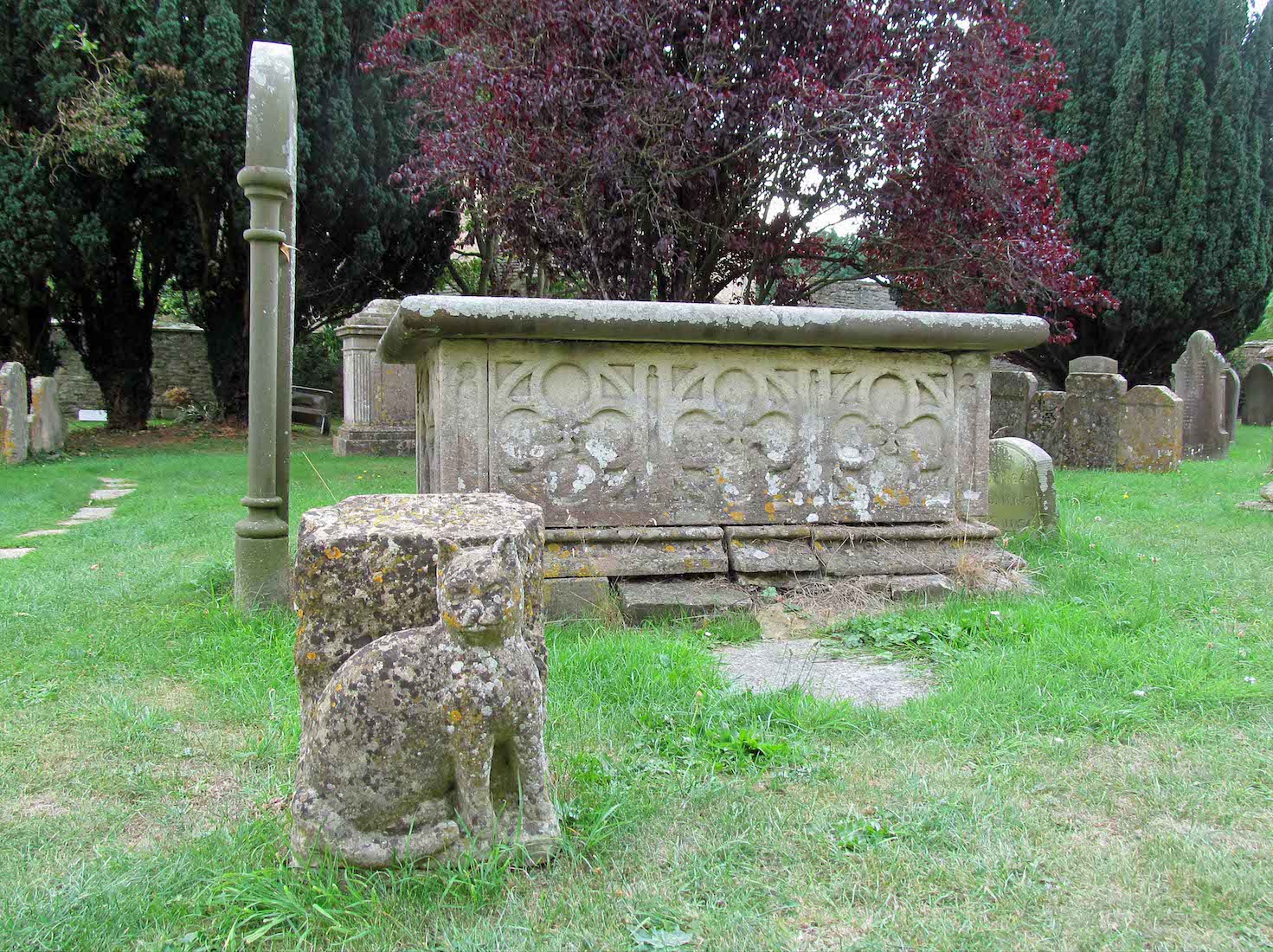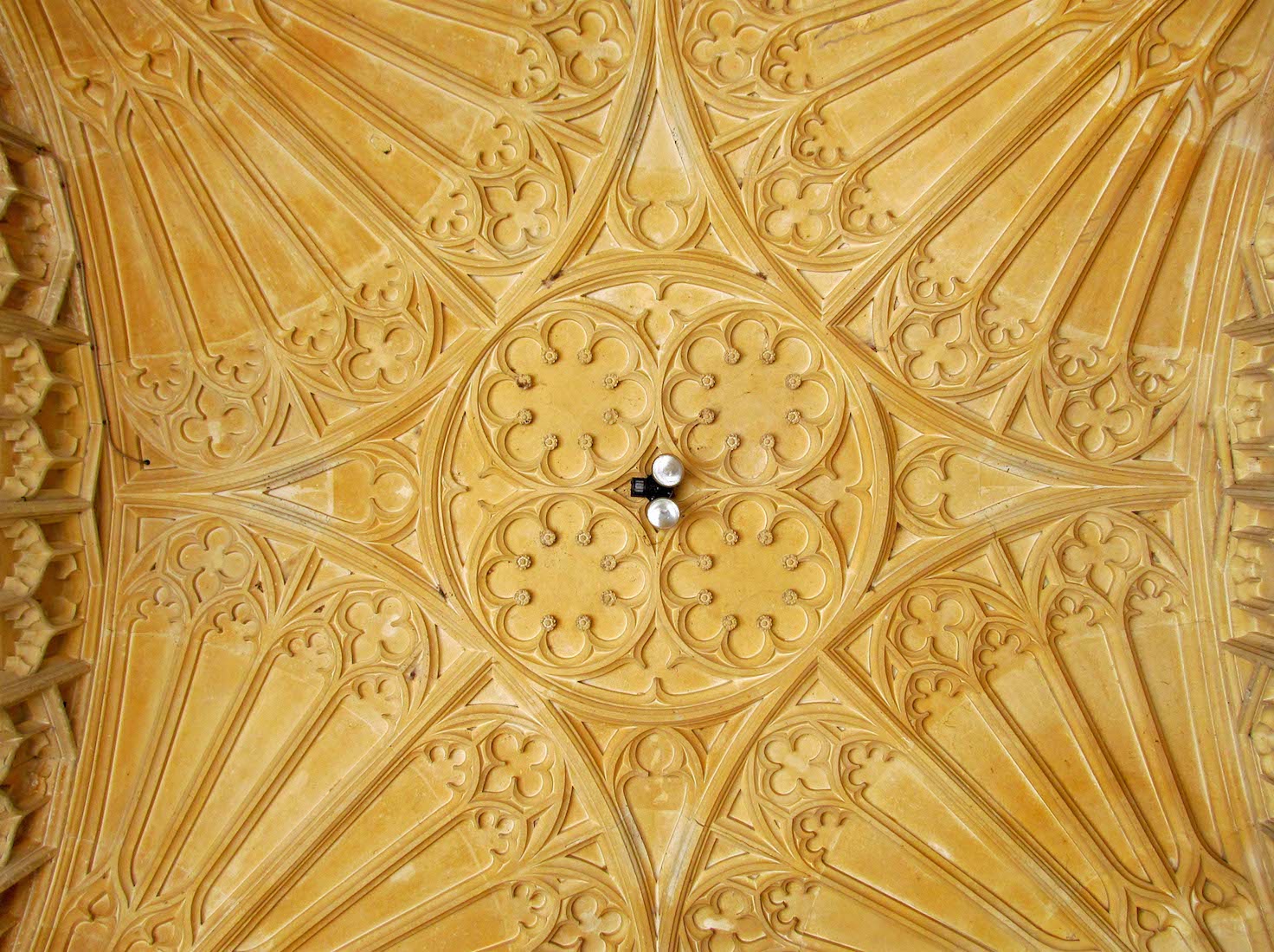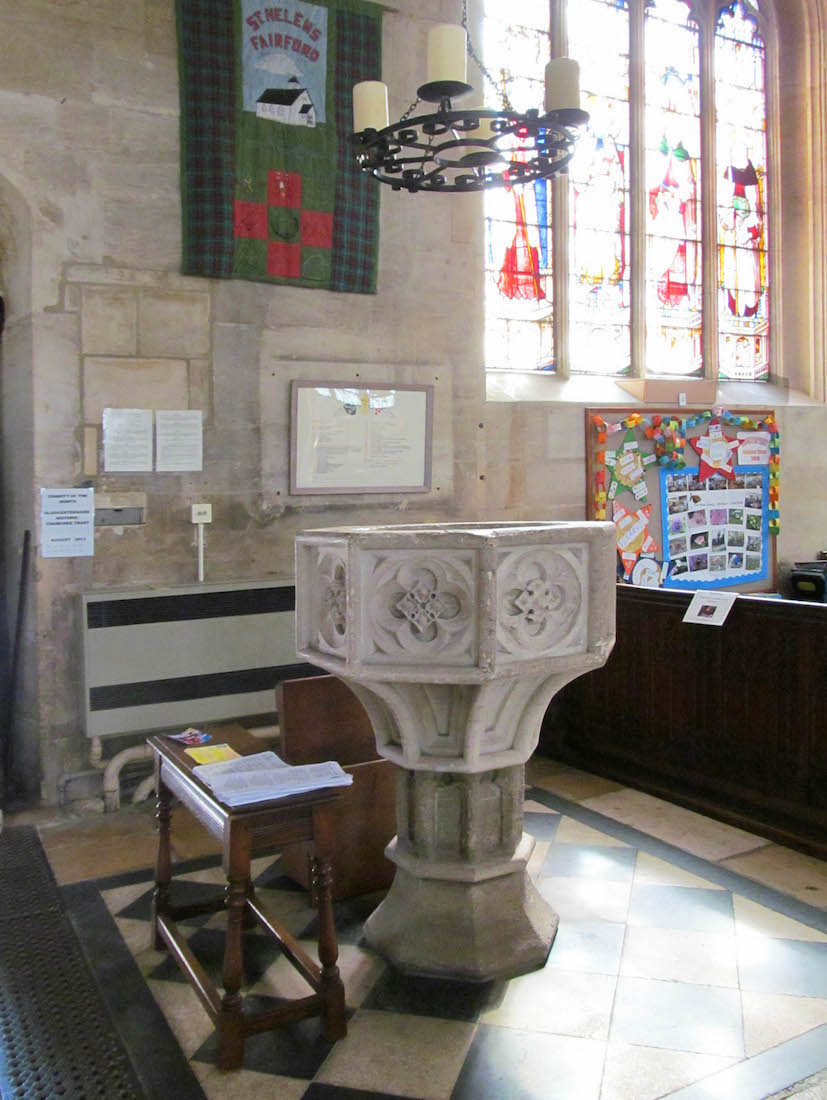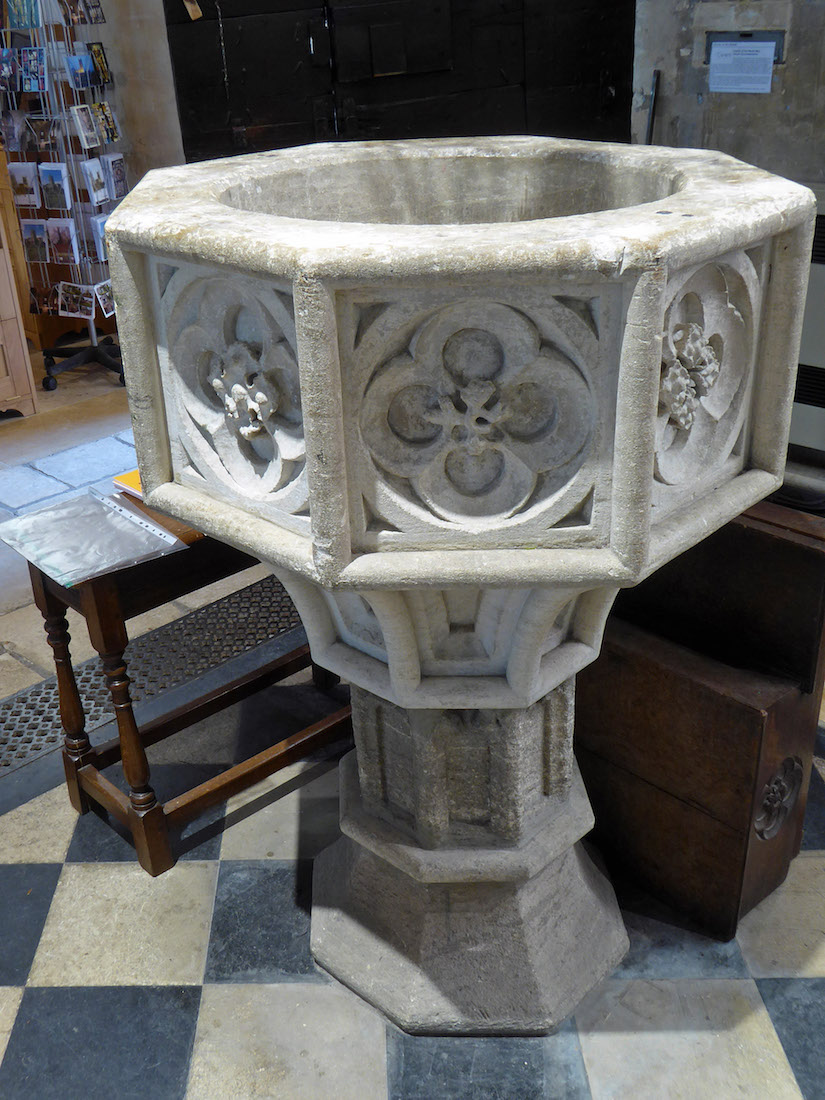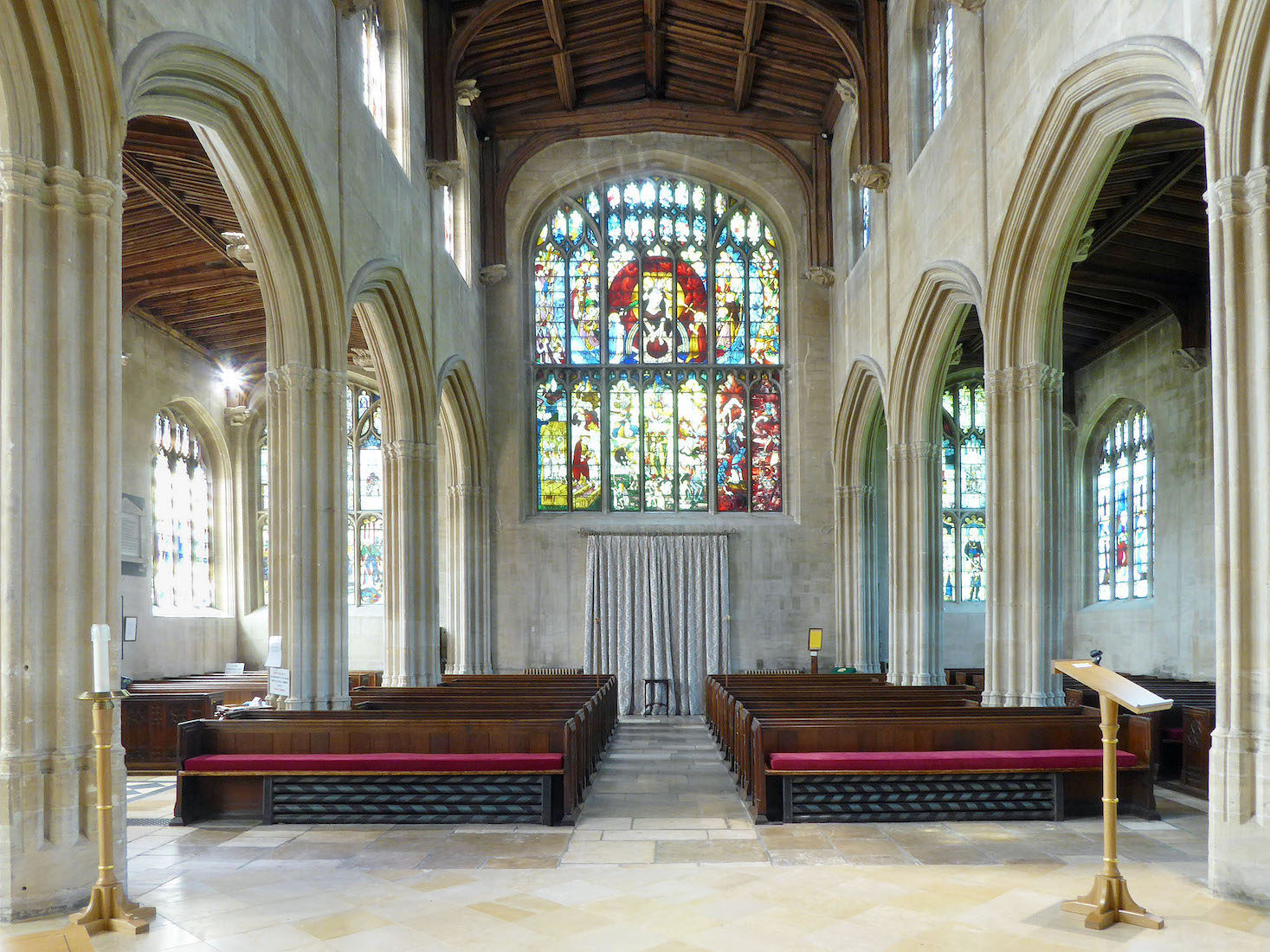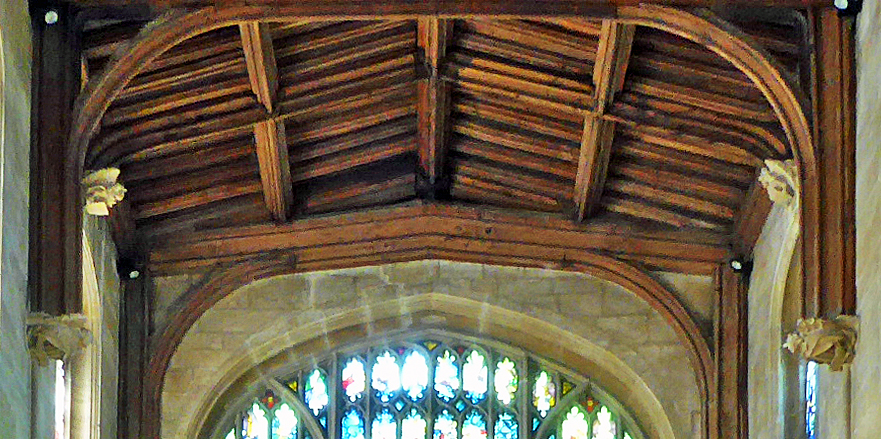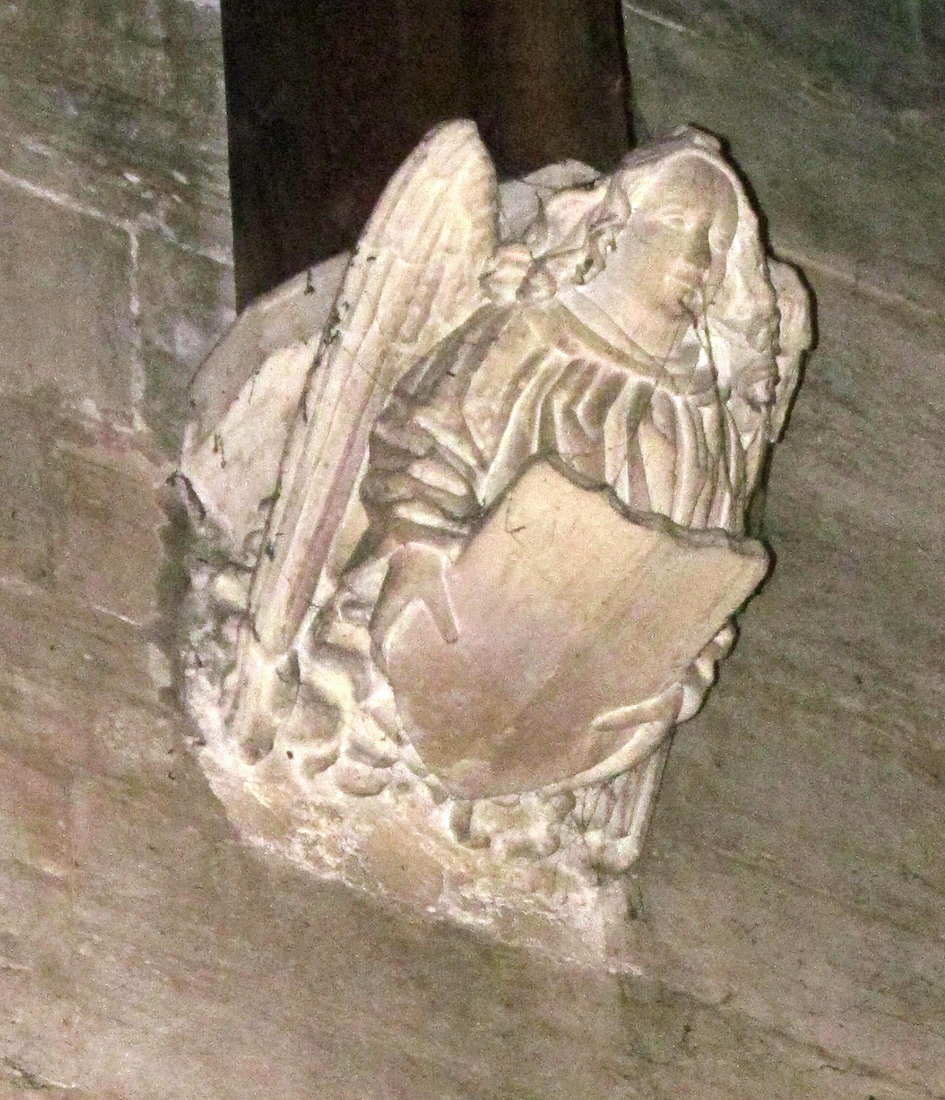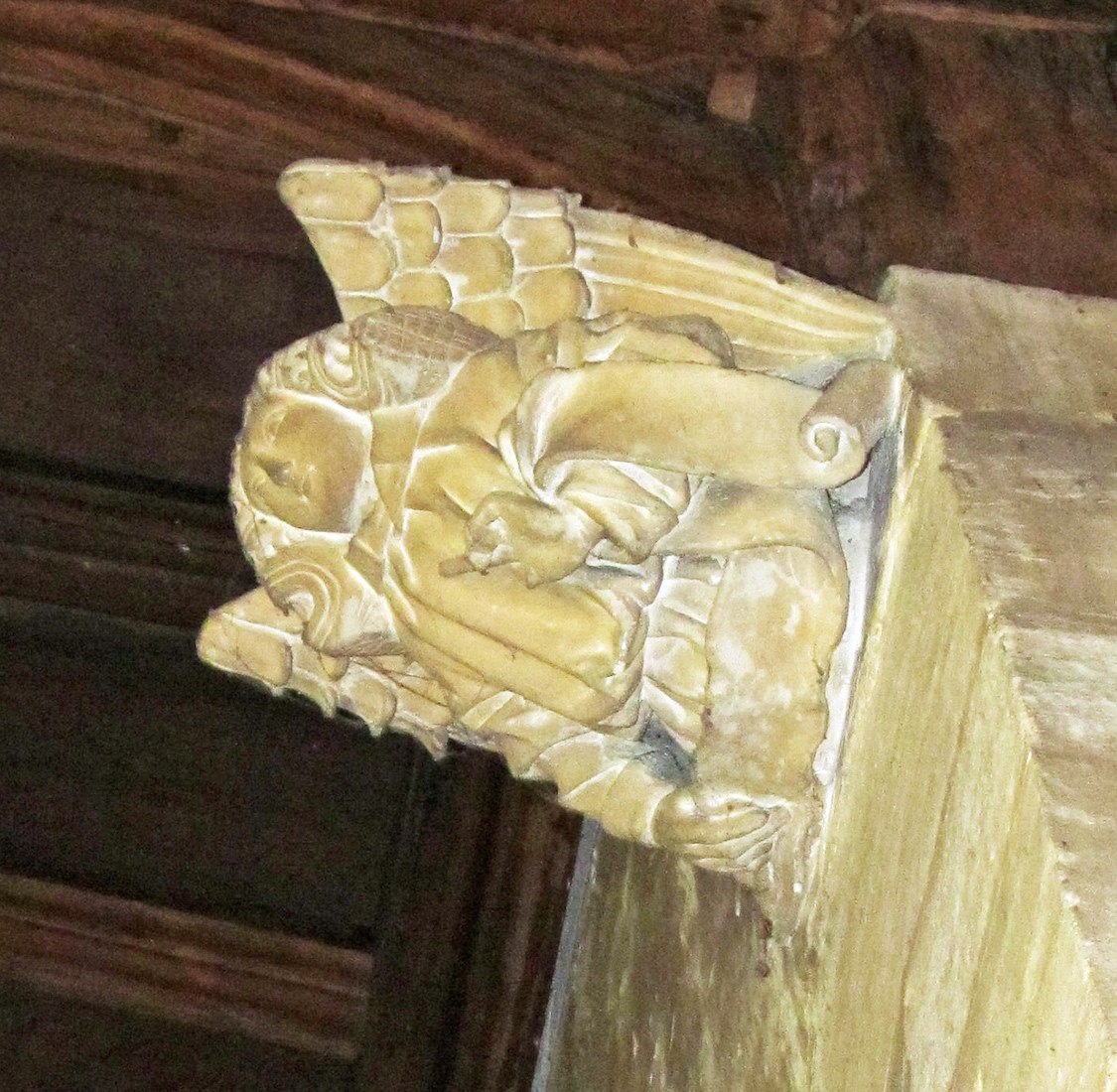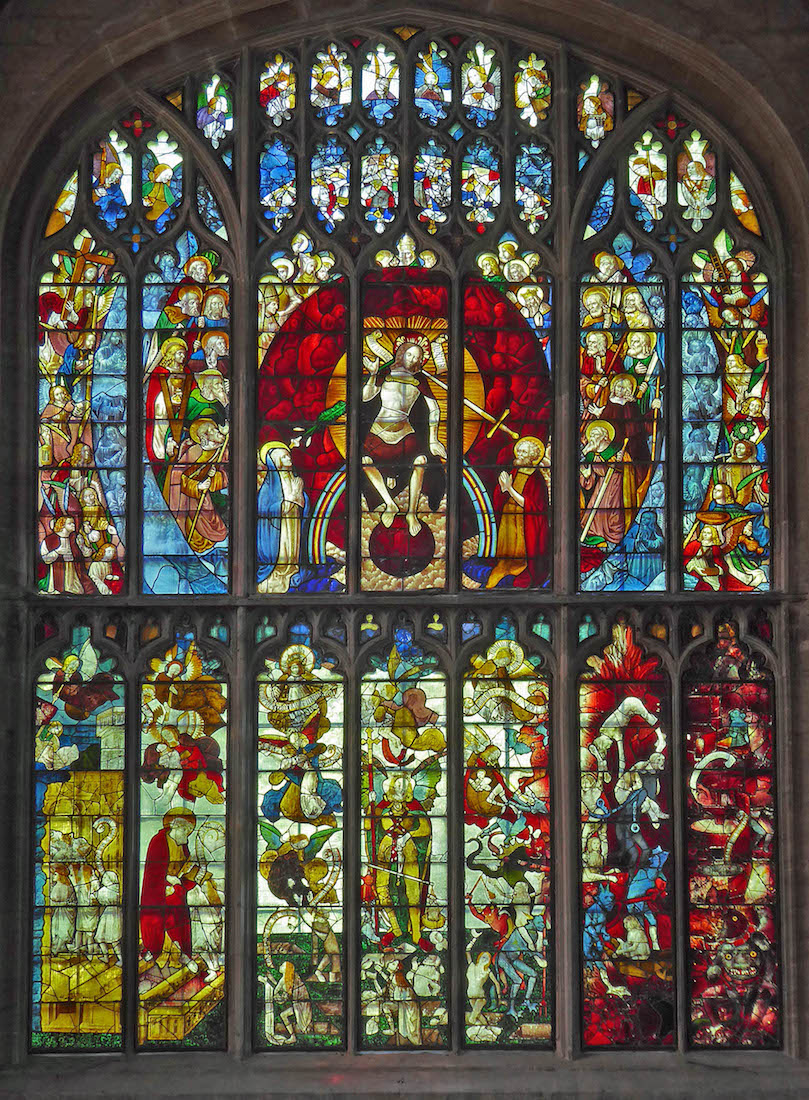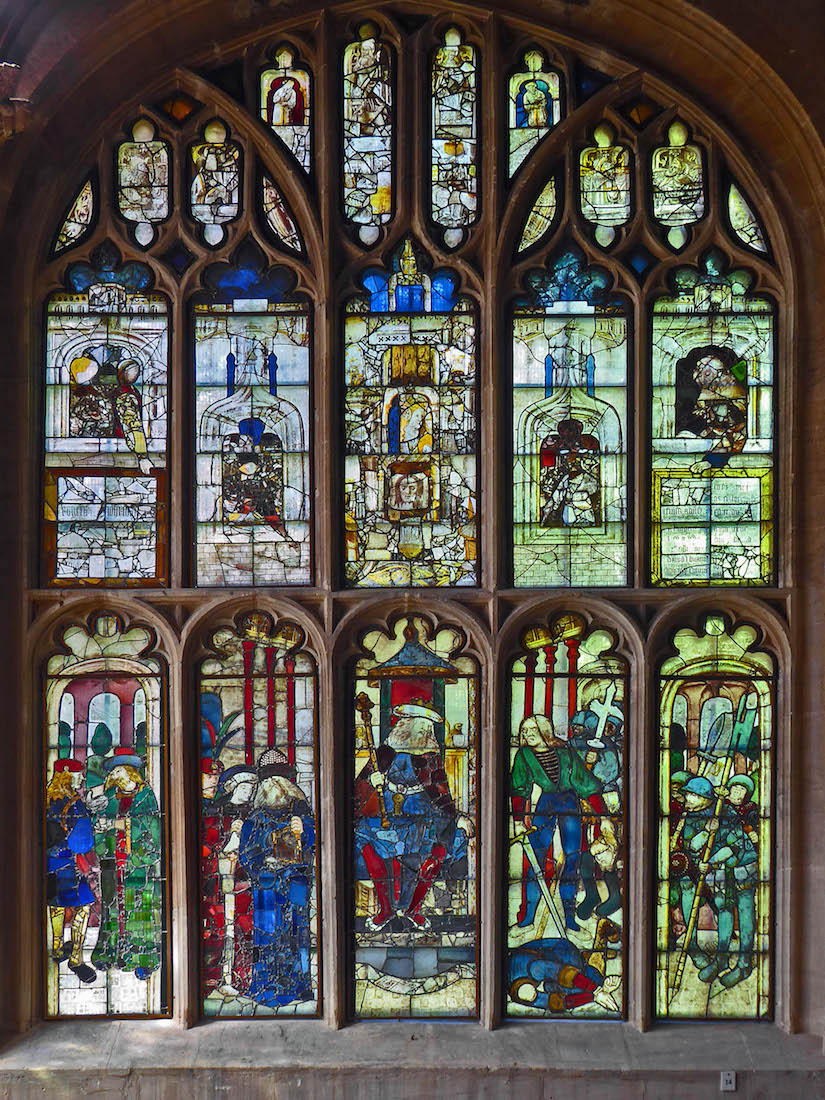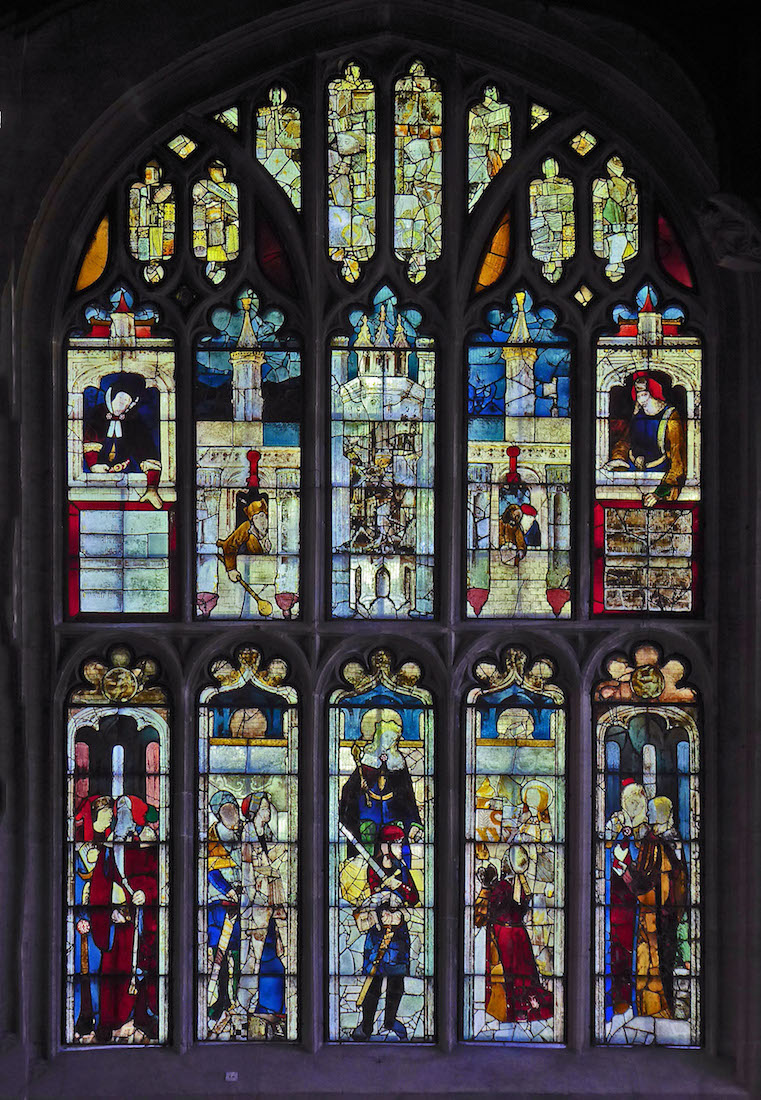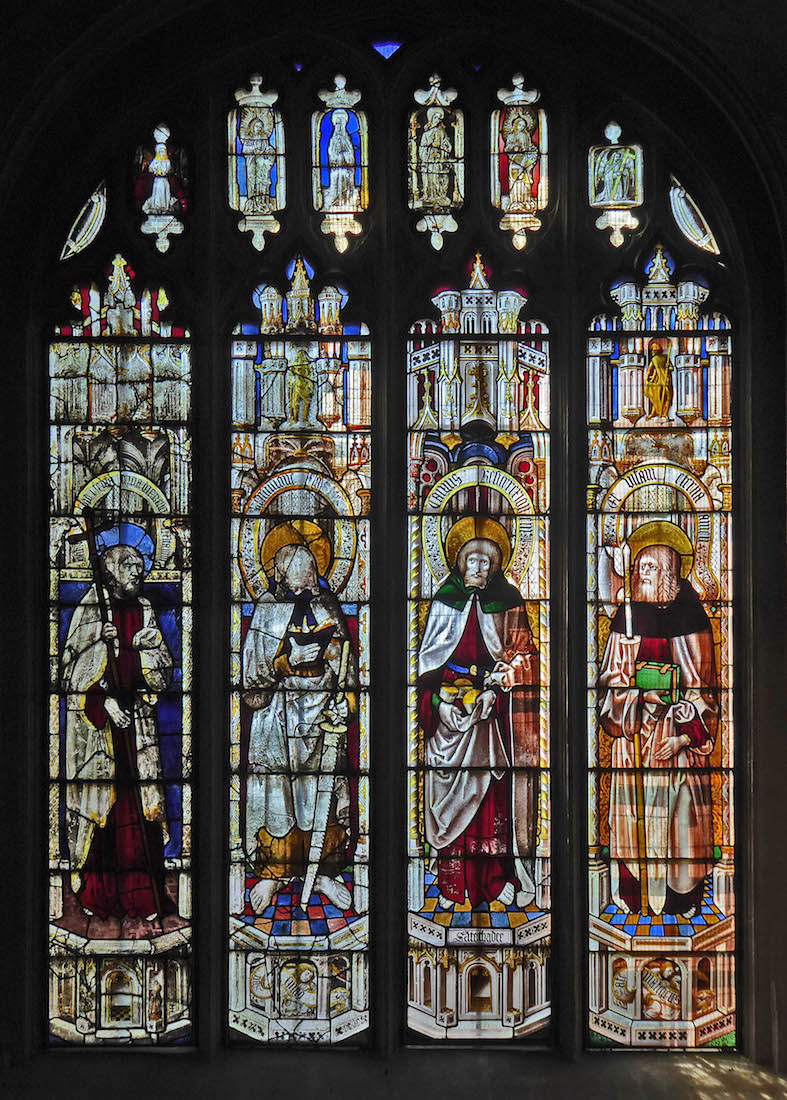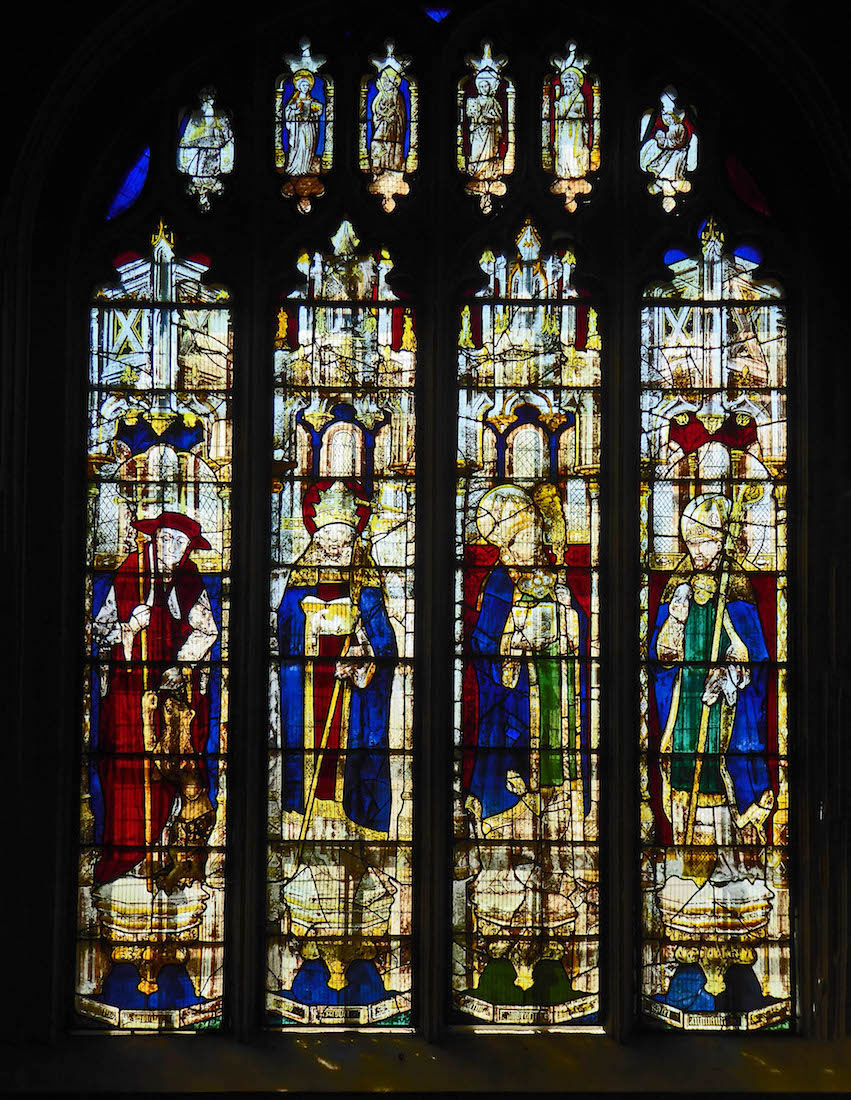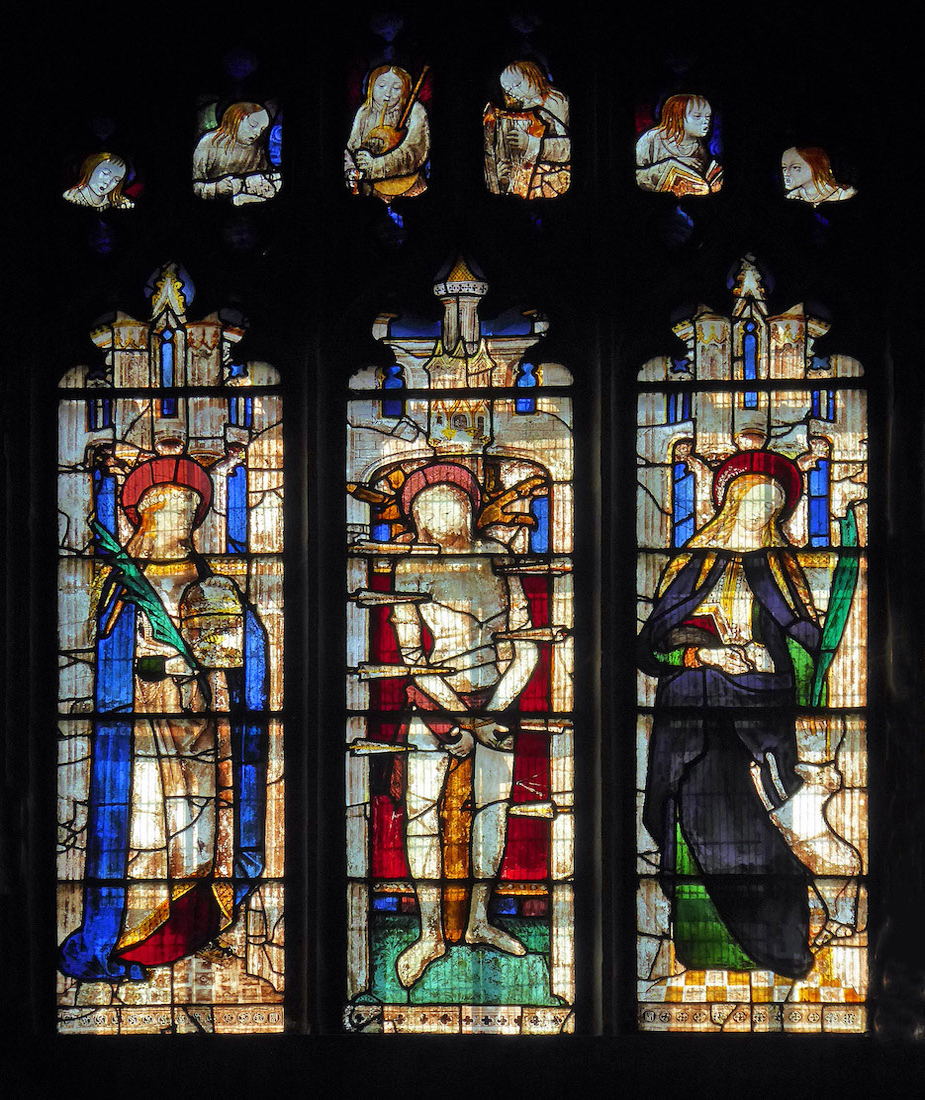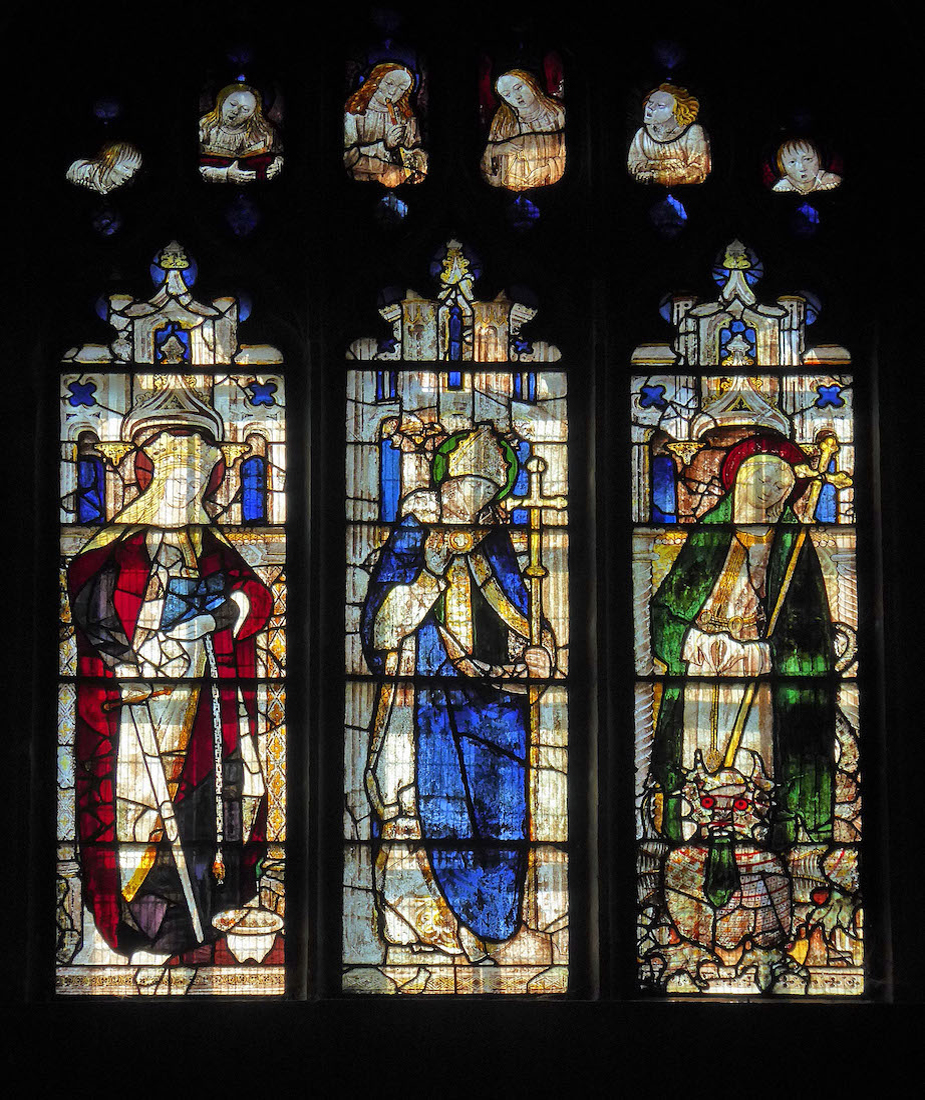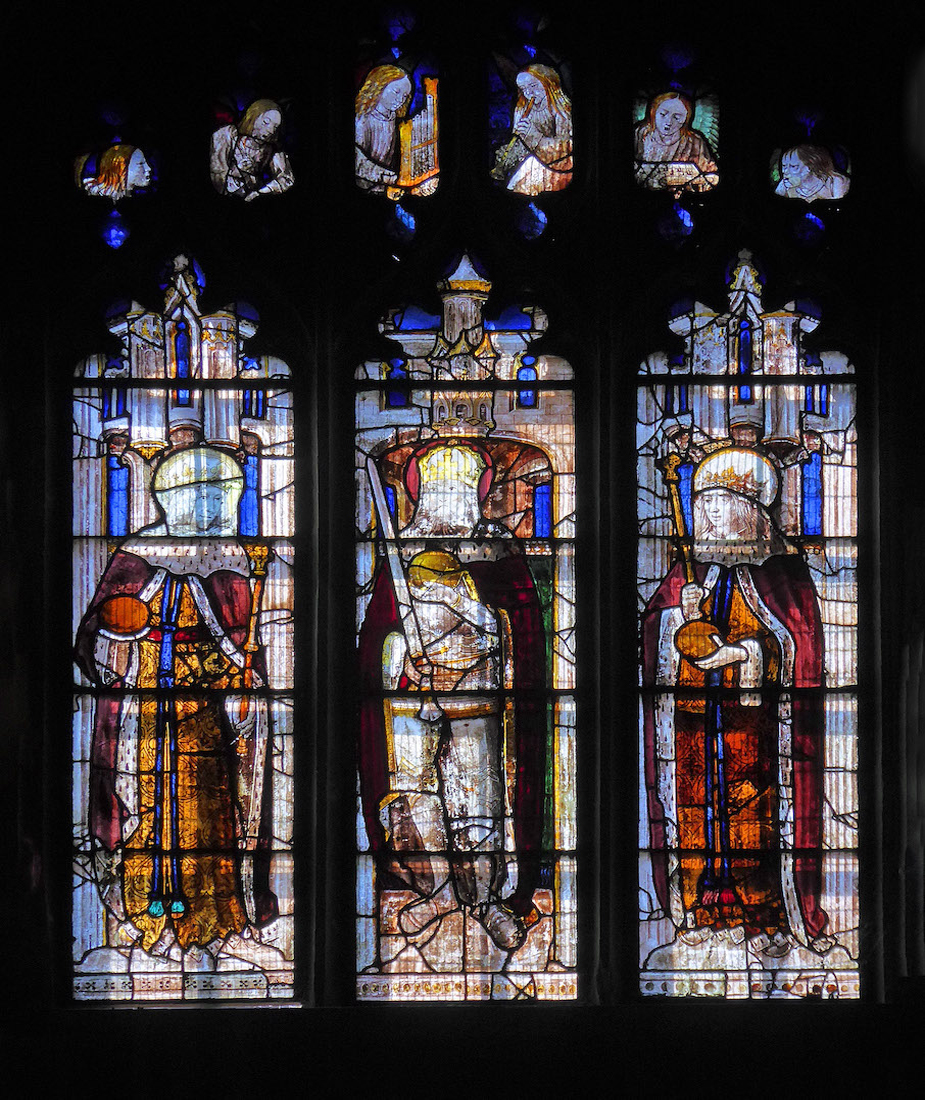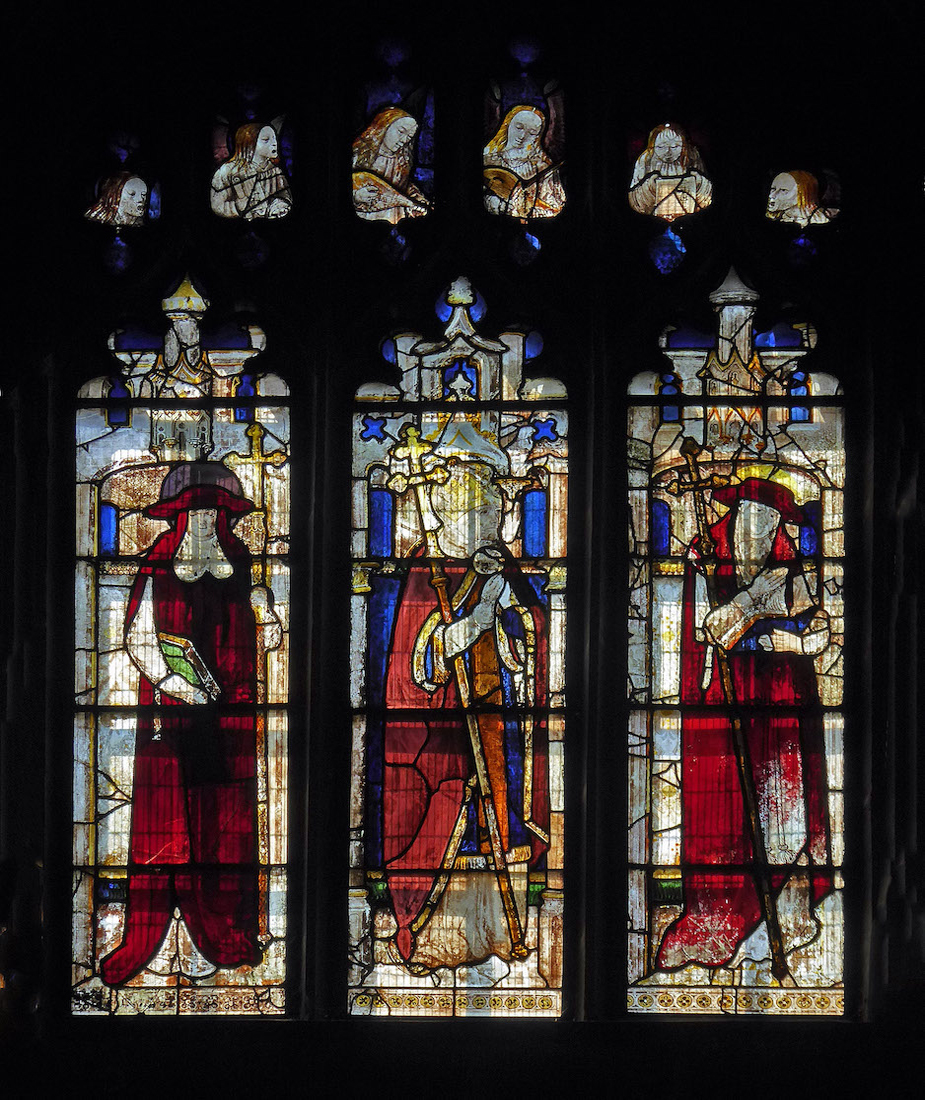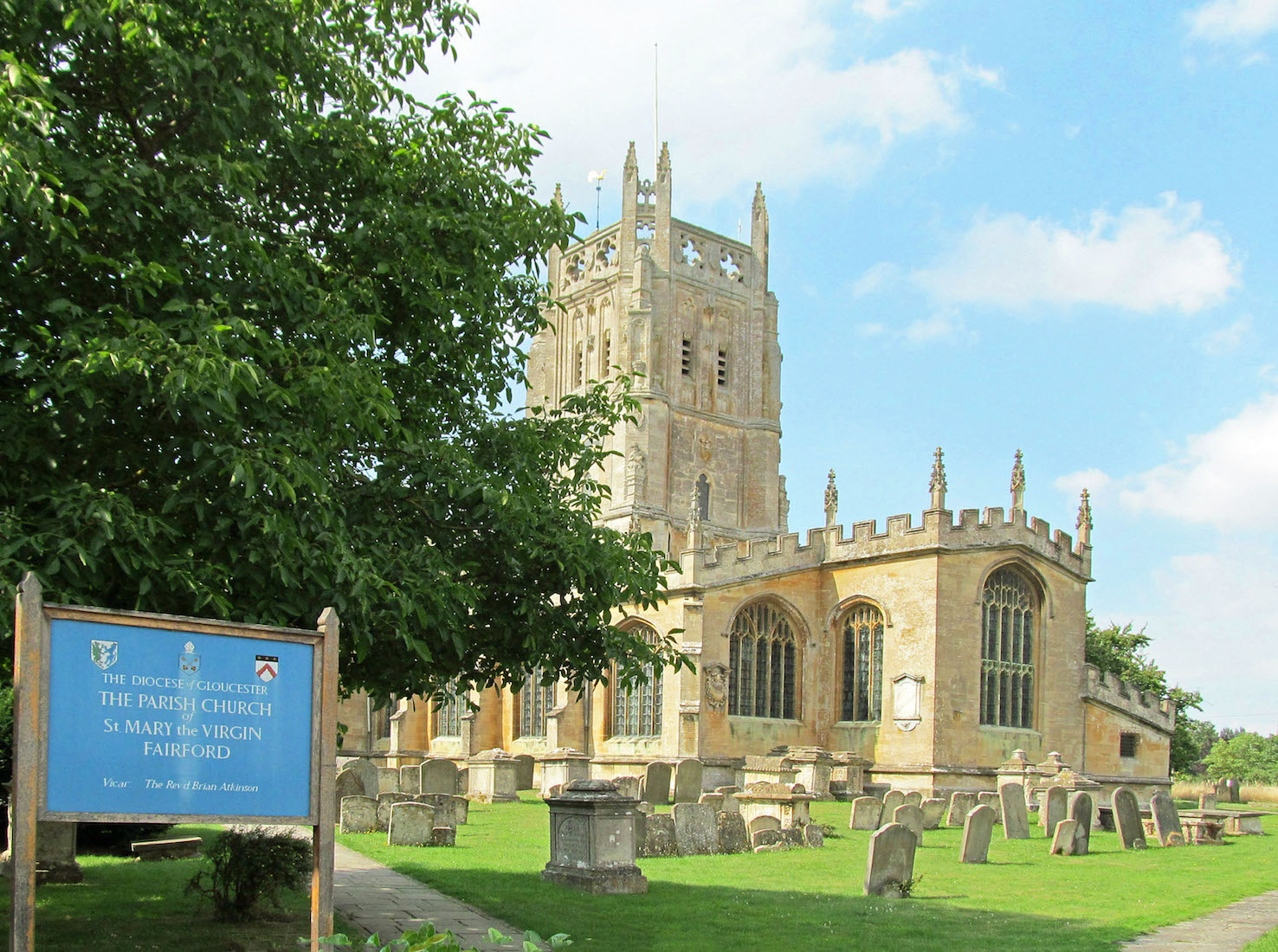
The main approach to Fairford’s Church of St Mary the Virgin is off High Street, where a path leads in beside a blue sign. In fact all the most favoured views of the Church are from near here, although there is a fine more distant view of the tower from where Mill Lane crosses the River Coln. Fairford is an attractive small Cotswold town whose wealth derived from the wool trade. These days it is probably better known for the nearby RAF Fairford air base which hosts the world’s largest military air show – the Royal International Air Tattoo. INDEX
2. SOUTHEAST VIEW WH
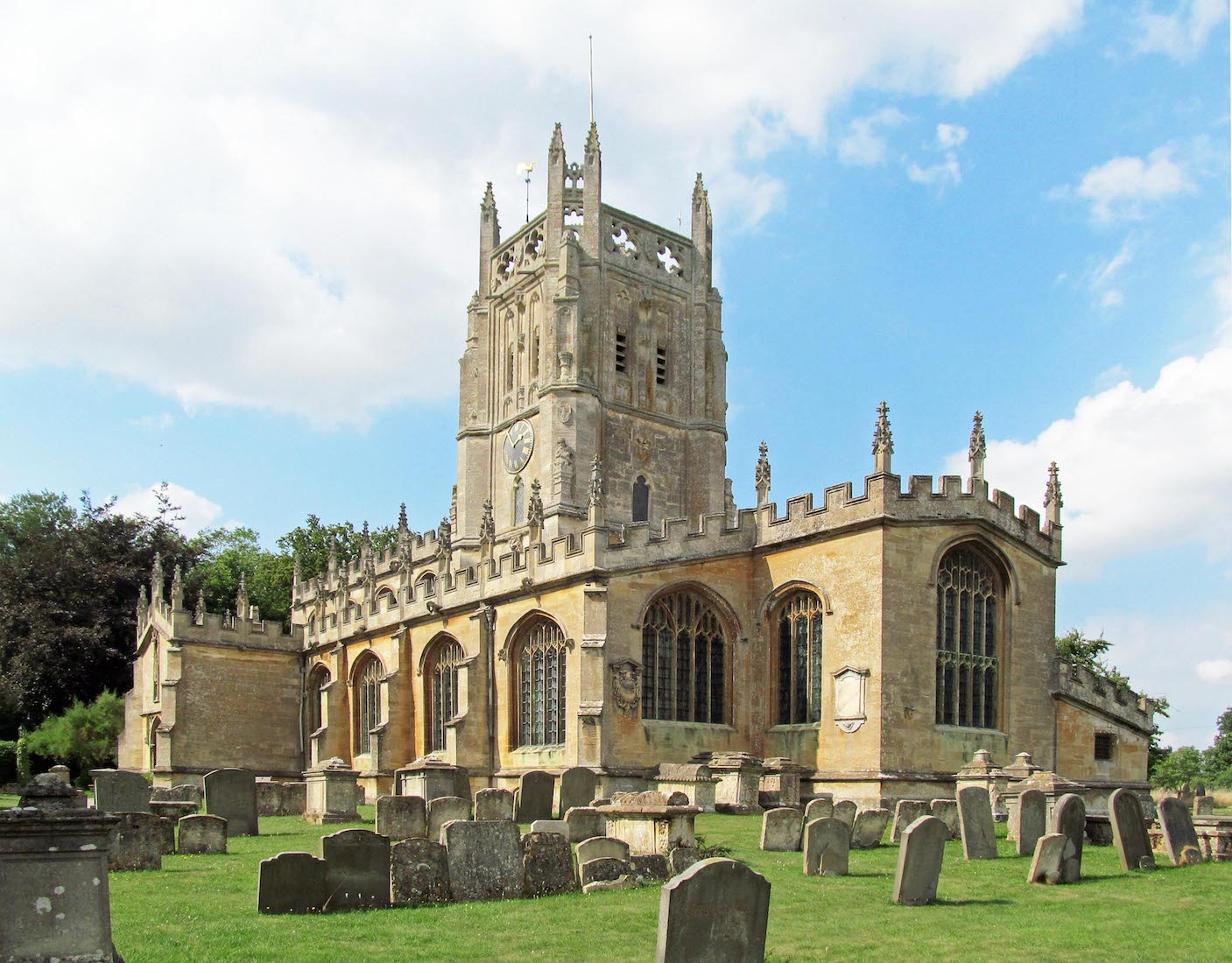
One can spend time looking at a church plan, but it is always a joy to see the actual Church! The large square tower captures our attention, but the there is the large South porch at left. A less impressive vestry has been added at right. Then there are so many headstones, seemingly randomly scattered all around the Church. The windows are a prominent feature, and are separated by supporting buttresses. The walls have a capping crenellation, and regularly spaced crocketted pinnacles.
3. SOUTH WALL AMT
On the Church building closest to us are two memorials. These commemorate three of the Morgan family – local landed gentry who died in the early 18th century. Unfortunately the inscriptions on the monuments have suffered very badly from erosion over the years. The closer Baroque monument on the East wall of the Corpus Christi Chapel (facing the High Street) is virtually unreadable, only the last three sentences still being visible. This is the monument to Mary (1682-1715) the wife of Edmund Morgan. The other monument is on the South side of the sanctuary, and has totally degraded to the extent that no lettering now remains. This is the monument to Charles Morgan (1715-1754) and his wife Elizabeth (1714-1772). The original text of these memorials can be found at
https://dev.fairfordhistory.org.uk/wp-content/uploads/2019/01/23_MORGANS-1772.pdf
4. TOWER AND SOUTH WALL AMT
When St Mary’s was rebuilt in 1490, the original 14th century tower was retained and heightened, and the new Church built round it. The Church tower and bells are therefore unusually located in the middle of the Church. There is a ring of 8 bells at St Mary’s and these were recast in 1927. The tenor bell, the heaviest, weighs 17cwt (882kg) and is inscribed: Henry Lewis Churchwarden 1735. The bells are rung from the floor of the church, in the choir area, so ringing must end and the bell ropes raised before the service can begin. • Looking closely at this wall, we can see a number of ornamental features.
5. GROTESQUE WH
These include this grotesque grotesque!
6. ROOF AND TOWER FIGURES WH
We might also see this climbing boy, and on the corner of the tower a guard who perhaps does not appreciate the bells!
7. EAST WALL AMT
The East wall faces out onto High Street, with the East windows of the Corpus Christi Chapel, the sanctuary, and the Lady Chapel. The added vestry at right has been given a low profile so as not to obstruct the window of the Lady Chapel. We notice evidence of a past monument on the sanctuary wall.
8. NORTHEAST VIEW AMT
We can wander amongst the graves to obtain this pleasant view of the Church.
9. NORTHWEST VIEW AMT
We continue our circuit of the Church, walking around past the North wall. There are many windows in this Church! The West wall is unusual in that there is no doorway.
10. TIDDLES! WH
Near the South porch is this memorial to Tiddles who was for 17 years the tabby cat at St Mary’s from 1963 until her death in 1980. Having befriended the verger and his wife, she stayed on and became a firm favourite, attending services regularly and sitting on the knees of willing members of the congregation. A local stonemason, Peter Juggins, felt that when she died she deserved a memorial at least as much as some of the people who already had one (‘more, in some cases’, said a commentator), and so he carved the likeness that stands outside the church porch today (right). The text on top of the stone reads: ‘Tiddles // the Church cat // 1965 – 1980’.
12. FAN VAULTING WH
Once inside the porch we look up to see this unexpected fan vaulting. The fan-vault was renewed in 1892 by Waller.
13. DOORWAY TO NAVE WH
The other interesting feature of the South porch is the old door through to the nave – in two parts and studded with nails. We squeeze through ... !
14. BAPTISMAL FONT WH AMT
Just inside the entry from the South porch stands the baptismal font. Since baptism symbolises entry into the Christian life and entry into the Church community, the font is often placed close to the Church entry door. This font has an attractive wooden cover which unfortunately was not on public view during our visit. The octagonal font is C15 and bears the Yorkist ‘Sun in Splendour’. There is a long story about this symbol, told at https://erenow.net/postclassical/lancasterandyork/18.php
15. NAVE LOOKING WEST AMT
We move to the centre of the nave, and look towards the West wall. To our sides are the fine fluted white columns supporting the Gothic arches. Above us is a rather roughly finished timber gable roof with decorative angels at the supports. Before us is the Great West Window which is definitely of interest. We notice too here the windows in the West wall on either side. I am intrigued as to what lies behind the central grey curtain, but perhaps it is just the wall!
16. NAVE ROOF AND ANGELS AMT WH WH
The timber roof has been in place a long time. It is supported by beams which have angelic support. Perhaps there is a lesson here ... .
17. GREAT WEST WINDOW AMT
The West window [15] shows the Last Judgement. Although the top section is a Victorian replacement, the lower section is one of the highlights of medieval art in Britain. In the centre is St Michael with scales, weighing souls. To left St Peter helps the saved ascend stairs to heaven. To the right are souls descending to hell, where torments await them. Satan waits in the lower right. He is shown with a torso like a head, a fish head, and a green tail. Look to the lower left, where a figure with ringlets is led into heaven. This is thought to depict Henry VII. Tap / Click here to see some window details.
18. SIDE WEST WINDOWS AMT
These are the two outer windows on the West wall [14], [16]. At left is the Judgement Hall of David: the main scene shows the beheaded body of The Amalekite. At right we see King Solomon’s Judgement Hall: the familiar story of Solomon threatening to cleave a baby in two, with two women each pleading to be declared the child’s mother.
19. SOUTH WINDOWS WEST OF THE PORCH AMT
The window at left [12] depicts the apostles: St Matthew (cross-staff), Simon (saw and book), Judas Thaddeus (cakes), and Matthias (halberd and clasped books) The window at right [13] shows Four Latin Doctors: St Jerome, St Gregory the Great, St Ambrose, and St Augustine of Hippo.
20. SOUTH CLERESTORY WINDOWS AMT
The four Southern clerestory windows [21] – [24] show Twelve Martyrs and Confessors of the Faith. From left are shown: St Dorothy, St Sebastian, St Agnes; Fragments, St Margaret, a Bishop; a King, an Emperor, a King; and a Cardinal, a Pope, a Cardinal.


